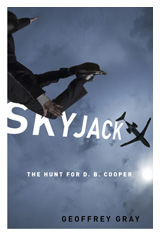Skyjack: The Hunt for D.B. Cooper| By Geoffrey Gray | Crown | 302 pages, $25.00
In the winter of 1971, a man calling himself Dan (misreported as D.B.) Cooper used a bomb to hijack a 727 boarding from Portland, Oregon, and extort $200,000 from Northwest Orient Airlines—he forced a pit-stop so the cash could be delivered– before jumping out of the plane with a parachute, 10,000 feet above southwest Washington. Neither he nor most of the money has ever been seen since, and the case remains the only unsolved skyjacking in American history. At least, that was the case until the FBI recently announced it had a new suspect, stoking hopes that the decades-long mystery might finally be solved. Alas, the bureau’s new lead turned out to be, like so many before it, a phantom vanishing into thin, high-altitude air.
 In July 2007, New York magazine contributing editor Geoffrey Gray received a tip from a private investigator about a new suspect in the case. Gray wrote a terrific feature on his lead and the case in general, and he has expanded his piece into this book, which is as much about the search for D.B. Cooper as about the initial crime.
In July 2007, New York magazine contributing editor Geoffrey Gray received a tip from a private investigator about a new suspect in the case. Gray wrote a terrific feature on his lead and the case in general, and he has expanded his piece into this book, which is as much about the search for D.B. Cooper as about the initial crime.
Unlike in the New York article, here Gray has unwisely made himself into a feature character. His meeting with the P.I., his moods and false starts, become part of the story. Devotees of the D.B. Cooper cult have been attempting for forty years to solve the case with little success, and Gray quite ham-handedly becomes a member of the club, just another weirdo obsessed with answering a piece of American trivia. By the end, when Gray depicts himself living alone in a cabin in snowy upstate New York to concentrate on the case—“I don’t know what day it is now and it doesn’t matter because Cooper sleuths do not stop the hunt for weekends”— I was reminded of the 2007 film Zodiac, about the quirky individuals infatuated with solving a different early-1970s mystery. But whereas that film’s focus on the amateur crime-solvers was novel and poignant, here it just feels distracting and predictable.
Gray’s decision to foreground not the case but the searchers is not the only mistake marring Skyjack. Most of the book is chopped between the present-day search and past characters and incidents. The actual skyjacking, for instance, is interspersed with details about many different suspects, all thrown together with no clear order or reason. Again, the message is obvious: the Cooper case is a mystery, with clues and suspects intertwined bafflingly and no clear answers emerging. But the effect is to confuse the reader and disrupt the narrative. And the sparse references to Richard Nixon and other 1970s iconography as background to the hijacking are unnecessary, forced, and unrevealing.
All of these literary and artistic errors are a shame because Gray has done terrific research for Skyjack. For those of us fascinated with the Cooper mystery—I have been since I saw a segment on Unsolved Mysteries a few years ago—Skyjack is in many ways a treasure. Gray got exclusive access to the FBI files on the D.B. Cooper case, and he turns up a lot of new material. He painstakingly travels across the country to interview suspects, follow up leads, and corroborate information. New York magazine deserves great credit for financing at least part of Gray’s search for the perpetrator of a single bloodless crime four decades ago.
Equally useful is Gray’s willingness to exercise his judgment. As a professional journalist, Gray is willing and able to sift through evidence to discern what is and is not useful in solving the case. He sizes up individuals well—the case, unsurprisingly, has attracted many kooks, and Gray exposes them as such. After meeting with one source, he determines, “I want to get out of here. Fast.” Nobody can blame him. The characters with which he interacts are colorful and occasionally hilarious, but wearying in their unseriousness. The Cooper case called for a writer as seasoned and cynical as Gray, and those unacquainted with the mystery will find themselves sucked into the vortex, if not with as much tension as a different writer might have mustered.
It will come as no spoiler to learn that Gray never solves the D.B. Cooper case. At several points, Gray writes that he can neither rule out nor rule in certain suspects. If unsatisfying, at least it is an honest admission. A forty-year old mystery is not going to be solved just because it would make for a better book ending, though it is particularly maddening when several of Gray’s sources refuse to reveal information because they have decided to write books of their own. Alas, that’s how it goes with the D.B. Cooper legend—searching only leads to frustration. Sadly, the same thing can be said about Geoffrey Gray’s new book.
Click here for a complete Page Views archive.
Jordan Michael Smith is a contributing writer at Salon and the Christian Science Monitor.
